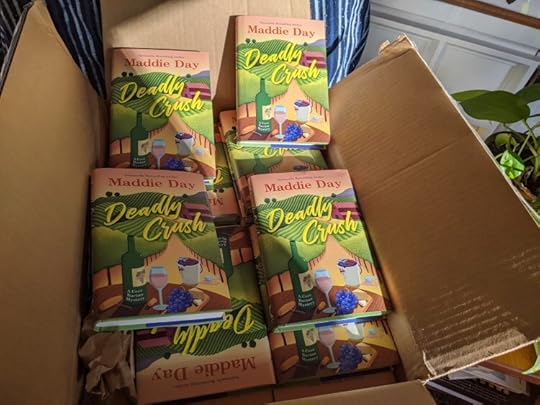The Cycle of a Book plus #giveaway
Edith/Maddie, usually writing from north of Boston.
But today I’ve accompanied Hugh to Mass General Hospital in Boston for his first hip replacement, which is day surgery. Because I’ll have a lot of waiting around until I can bring him home, I brought the final printout of the manuscript I’ve been working on since August. I can sit and work on that anywhere.
 OLYMPUS DIGITAL CAMERA
OLYMPUS DIGITAL CAMERAPhoto from Wikimedia Commons
Murder at Cape Costumers is due December 1, so this is nearly my last chance to read it straight through and make sure I’ve tidied up loose ends, made the clues and red herrings work, and filled plot holes. It’s the seventh Cozy Capers Book Group mystery, and some big things are going on in Mac Almeida’s life, along with an important secondary plot.
I’ll have two more weeks before the deadline to tweak final bits, but in there is also care giving for my sweetie, Thanksgiving, which I host, and the release of Deadly Crush.
For this post, I thought I’d walk you through my process in writing a book. This is the 38th (I think) manuscript I’ve completed, so I pretty much know what I need to do in the four months I have to do it in. Other writers are sure to have different steps and different ways to accomplish the same goal, and there’s no one right way. (Beginners, don’t ever let anyone tell you there is!) But here’s mine:
Crank straight through the first draft. Because I’m not much of a plotter, sometimes that includes wading into the fog and pushing aside veils of mist, but I can usually get the bones of the story down in about two months.Revision pass A: I resolve all the places I left a note to self that reads, [CHECK THIS]. Some of it is research, some is checking prior books and series history, some is checking a scene I wrote toward the start of the current book. All those places would have slowed down my first draft if I’d bothered to check them at the time, and we all know what can happen when you head into the internet: you might not resurface for two hours.Revision pass B: Look at the storytelling. Does every scene relate to the one before and the one after? Do beginnings and ends of scenes grab the reader’s attention? Does every scene move the story forward?Revision pass C: Look at the language. Do I include the senses where they enrich the book? Have I used the most elegant language I can in the service of the story? Do I have too many dialogue tags or not enough? Are descriptions important to the story or will they make readers skip them? And so on.First paper readthrough: Print it out, sit and read it straight through like a reader will, and mark up the paper with a green pen. Then fix all that stuff and run a spellcheck.Send it off to an independent editor. Work on a short story or clean my office in the interim.Fix what she recommends. I usually knock off all the easy stuff and then address the stickier parts. Second paper readthrough: It’s just like the first one. That’s what I’m doing today. (I print on the other side of already printed paper that a couple of friends save for me, so it’s less waste of paper than you might think.)
9. If I have time, I like to read the whole thing aloud. (Some people have Word do this.) It’s amazing what you can catch by hearing the book.
10. Final tweaks, final spellcheck, and send it off to my Kensington editor.
More steps happen after the manuscript is accepted, like editorial comments, copyedits, and proof pages, thank goodness. And then the book is printed and ebooked and recorded in audio and released into the world! That’s happening next Tuesday with Deadly Crush. Look, my box of books came in!

Readers: Questions about the process? Did anything about it surprise you or seem to be missing? I found one last ARC of Deadly Crush I’d love to send one of you.



